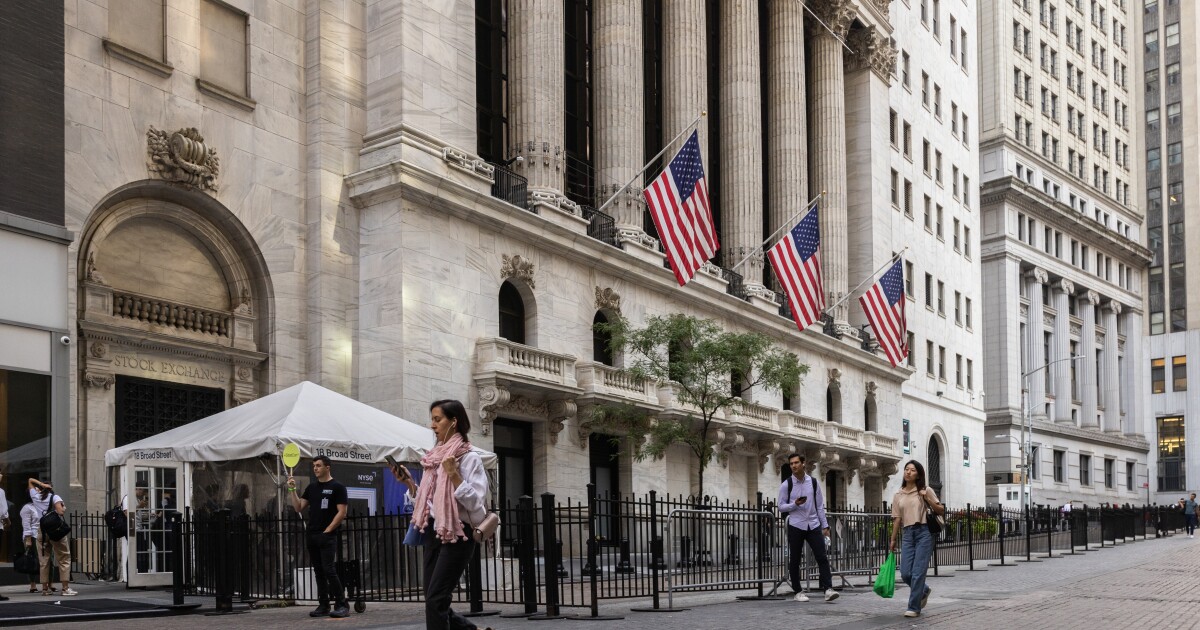
Stocks saw their first back-to-back drop in six weeks as traders weighed prospects of
Wall Street are paring back bets on aggressive policy easing as the U.S. economy remains robust and Fed officials have sounded a cautious tone over the pace of future rate decreases. Rising oil prices and the prospect of bigger fiscal deficits after the upcoming presidential election are only compounding the market's concerns. Since the end of last week, traders have trimmed the extent of expected Fed cuts through September 2025 by more than 10 basis points.
The stock market has rallied this year thanks to a resilient economy, strong corporate profits and speculation about artificial-intelligence breakthroughs — sending the S&P 500 up over 20%. Yet risks keep surfacing: from
"While recent data indicate a more resilient U.S. economy than previously thought, the broad disinflation trend is still intact, and downside risks — albeit lower — to the labor market remain," said Solita Marcelli at UBS Global Wealth Management. "We continue to expect a further 50 basis points of rate cuts in 2024 and 100 basis points of cuts in 2025. This should bring Treasury yields lower."
A string of stronger-than-estimated data points sent the U.S. version of Citigroup's Economic Surprise Index to the highest since April. The gauge measures the difference between actual releases and analyst expectations.
"On the back of September's strong economic data, markets have already priced a slower pace of cuts," said Lauren Goodwin at New York Life Investments. "If the Fed is able to move towards a 4% policy rate — still above the levels most believe represent the 'neutral' rate — then the equity market rally can continue. Disruptions to that view make equity market volatility more likely."
Most Fed officials speaking earlier this week signaled they favor a slower tempo of rate reductions. Policymakers at their meeting last month began lowering rates for the first time since the onset of the pandemic. They cut their benchmark by a half percentage point, to a range of 4.75% to 5%, as concern mounted that the labor market was deteriorating and as inflation cooled close to the Fed's 2% goal.
"We can point to a few reasons for the rise in global long rates but one possibility is that markets are giving a big thumbs down to central banks easing policy before we've seen a sustainable drop in inflation." said Peter Boockvar author of The Boock Report. "I remain bearish on the long end and bullish on the short end."
The last time U.S. government bonds sold off this much as the Fed
Two-year yields have climbed 34 basis points since the Fed reduced interest rates on Sept. 18 for the first time since 2020. Yields rose similarly in 1995, when the Fed — led by Greenspan — managed to cool the economy without
In prior rate cutting cycles going back to 1989, two-year yields on average fell 15 basis points one month after the Fed started slashing rates.
Meantime, the International Monetary Fund said the U.S. election is creating
"Presidents don't control markets," said Callie Cox at Ritholtz Wealth Management. "Over time, the stock market's common thread has been the economy and earnings, not who's in the Oval Office. Be prepared for mood swings in markets as we get closer to Election Day. But remember that election-fueled storms often dissipate quickly."
As the earnings season rolls in, U.S. companies are reaping the best
S&P 500 firms that posted better-than-estimated third-quarter earnings have outperformed the benchmark by a median of 1.74% on the day of reporting results, according to data compiled by Bloomberg Intelligence. That's the strongest rate in BI's records going back to 2019.
At the same time, companies missing estimates trailed the S&P 500 by a median of 1.5%, a less severe underperformance than the 1.7% experienced in the second quarter, the data showed.
"This earnings season we are watching what companies are saying about inflation and the economy," said Megan Horneman at Verdence Capital Advisors. "In addition, their view on interest rates, especially if the Fed cannot be as aggressive as the market is pricing in at this point. It is good to see analysts getting realistic about 2025 earnings growth. However, at 15% earnings growth, we believe it is still too optimistic given the expectation for slower economic growth in 2025."



